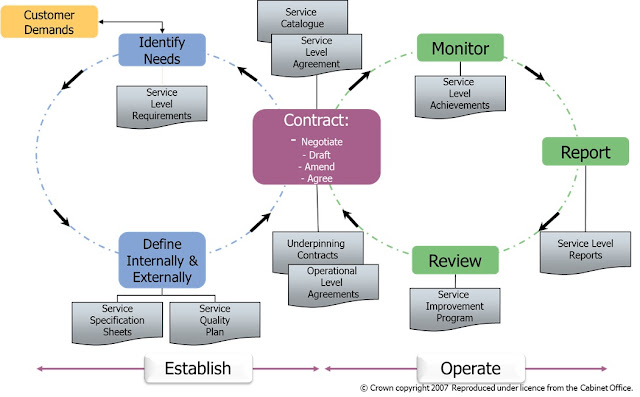I
am a great fan of analogies. I think it makes it so much easier for people to
understand the service management theory if they can relate it to something
already very familiar. My favourite one for describing the essence of a service
(delivering value without the ownership of specific costs and risks) is public
transport:
- You use the bus (or train) without worrying about the mechanics (bus-technology, maintenance, etc.)
- You pay a fixed-price every time (not related to variable fuel-prices, drivers-salaries etc.)
- It gets you where you want to go, in a certain time (=value)
Whilst there is still costs (the fare) and risks (you could have an accident), you don’t have to worry about these and can instead concentrate on other things during the journey (in my case angry birds).
I
could go on-and-on about this and other analogies (and probably will, but in
other blogs) but for this time I want to look at the one I use to explain the
activities of the Service Level Management (SLM) process. In fact this is not
so much an analogy, but a ‘depiction’ with a reference to pop-culture.
It
is based on an old (v2) diagram showing the different activities in two
circles. The first cycle is around the ‘define-document-&-agree’, the
second ‘monitor-measure-&-report’. Originally these circles rotate
similarly (clockwise), but in my depiction I have turned one around so they
turn ‘into each other’. This way they become the wax-on and wax-off of
SLM (the pop-culture reference to the Karate Kid, either the original or the
half-hearted remake with Will Smith’s kid and Jackie Chan as Mr. Miagi).
Apart
from (hopefully) a good laugh, and a great way of memorising the various
activities, I think there is also a lot of benefit in this depiction:
The
two circles represent two distinct activity-streams within Service Level
Management. I have earlier retold how the perception of the Design (and
Strategy) processes is not that of one with a single input and a linear set of
activities leading to a single outcome\deliverable. But rather multiple
activity streams based on several distinct inputs and outcomes.
‘Define-document-&-agree’
(wax-on) is the Design-stream, in which SLM negotiates with the Customers (and
with the various technical functions and other design processes) to establish
the Service Level Agreements (SLA), Operational Level Agreement (OLA) and
Underpinning Contracts. These documents will form the basis of the further
Service delivery (through Transition and into Operations) as they identify the
service levels and targets to be achieved.
Those
achievements are the basis for the ‘monitor-measure-&-report’ cycle (wax
off) which occurs more in Operations. The operations processes (event & incident
management, request fulfilment …) provide operational reports, which (together
with those from the other processes such as change, capacity, availability …
management) give an overview of the service delivery against the designed
agreements.
The two cycles don’t operate independently: the output of the wax-on cycle (SLAs)
forms the basis of the wax-off cycle. The output of the wax-off cycle (reports)
are fed into the ‘review’ activity, which links this cycle back to the wax-on
one: if the reports indicate a service shortfall, opportunity for improvement
or and changed business requirement, we have to restart the wax-on of
‘define-document-agree’. The review activity therefor sits in the middle
connecting the wax-on and wax-off.
Of
course we can further detail this depiction by entering Service Improvement
(and Quality) Plans into it, or linking it to complimentary processes, CSI in
particular (but also some of the Strategy ones). But why complicate things when
a ‘simple’ diagram can provide enough insight for a good understanding of the
objective and activities of the SLM process.
I
think simplicity is a key in teaching the ITIL basics\foundations. Simplicity
without condescending, if we can clarify the complex concept of interrelated
processes in terms of depictions and analogies, we can spread the understanding
of service management to a much larger audience (zealots like myself, and
probably you, can then further discuss the finer details!).the ITIL Zealot
December 2012


No comments:
New comments are not allowed.